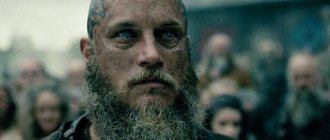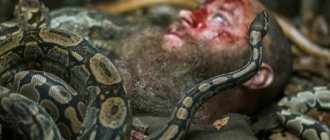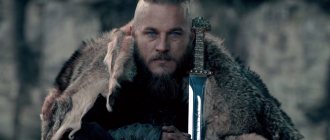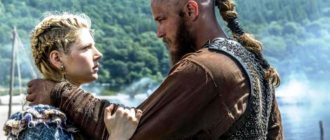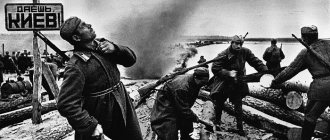Bjorn Ironside, who was a famous king and conqueror, was the famous son of Ragnar Lothbrok and Lagertha and lived in the 9th century. The young man was distinguished by an inquisitive mind, special determination and courage, wanting to follow in the footsteps of his father and become a strong warrior, a wonderful leader, opening new lands to the people, exploring distant countries. When Ragnar died, Bjorn took over his title of king and had every right to be called his successor and king of Sweden, the first ruler of the new dynasty.
Biography
Bjorn Ironside is a Viking, a Swedish ruler who lived in the 9th century, the son of the legendary Ragnar Lothbrok, a character in the Canadian-Irish TV series “Vikings” directed by Michael Hirst. According to Scandinavian legends, Bjorn Ironside was born in the 9th century into the family of Ragnar Lodbrok, a Danish king, the son of King Sigurd the Ring from the Yngling family. It is believed that Ragnar's father won the bloodiest battle against Harald Battletooth in eastern Gautland, as is known from the Scandinavian epic. The boy's mother was the third wife of the legendary ruler Aslaug, the daughter of Sigurd the Slayer of Fafnir.
Ragnar Lothbrok, father of Bjorn Ironside
There is no historical information or documents about the existence of Ragnar Lothbrok; the memory of the Danish king is preserved only in the legends and myths of Scandinavia. But many scholars agree that Ragnar is a real person.
First of all, the king became famous for his campaign against Paris, which he captured in 845. By this time, the Dane's squadron consisted of 120 ships and 5 thousand soldiers. In exchange for the integrity of the city, the Vikings demanded a ransom of 3 tons of silver from King Charles the Bald, which he paid. But the northern regions of Frankia were unlucky - all the cities and villages were destroyed and plundered by Ragnar’s army on the way back.
Ragnar Lothbrok captures Paris
The next important event in the life of the king was the campaign against Britain in 865, during which Ragnar was defeated by King Ella II. Due to erroneous navigation, the Danish ship ran aground during the battle, thereby becoming a living target for the enemy. King Ragnar was captured and executed in a pit with rattlesnakes.
Death of Ragnar Lothbrok
Lodbrok's wives - warrior Lagertha, Thora and Aslaug - gave the legendary warrior eleven sons - Eirik, Agnar, Sigurd Snake-in-the-Eye, Bjorn Ironside, Ivar the Boneless, Ubbe, Harald, Halfdan, Hvitserk, Fridleif, Ulva. In addition to his legitimate children, Ragnar also supported the children of his own concubines.
After the death of Lodbrok, the title of king went to his son Bjorn, who became the founder of the Swedish Munse dynasty. Brother Sigurd Snake-Eyes began to rule the rest of Scandinavia. To subjugate the territory of the northern country, Bjorn and his brothers killed Eystein Grom, the previous ruler. The history of the conquest of Sweden is described in the Saga of Herver and the Saga of the Sons of Ragnar Lothbrok.
Text of the book “Vikings. Storm behind the scenes"
I exposed my glorious life - at fifteen - beautiful-faced, I attacked the fish of the earth - from the generation of winters - to danger. If disaster had not struck me, my death would have come quickly - the lava of the salmon lying in the heart would probably not crawl.[5] 5
“The Saga of Ragnar Fur Pants”, edited translation, translation vis – Nadezhda Topchiy. [Close]
Skalds usually call a snake the fish of the earth, so Tora guessed that the young man told her that he was fifteen years old and that he had slain the snake.
Having learned that his will had been fulfilled, the jarl ordered to convene a crowded meeting, to which all people who did not want to anger the jarl were to come. The tip was stuck in the snake’s wound, and now the earl expected that his daughter’s groom would bring a spear shaft that would fit this tip.
Ragnar appeared at the Thing with all his people, there was already a dispute going on there about who would marry Thor, but only the shaft of Ragnar’s spear came to the tip.
So Thora became Ragnar's wife.
They lived together, and Thora gave birth to Ragnar two sons - Eirik and Agnar. They were both very tall, as the descendants of Odin should be.
But one day Tora fell ill and died. Ragnar took her death so hard that he did not want to reign and put his sons in charge of the state. And he again gathered his squad and went on a campaign and, wherever he came, he won victory.
The medieval monk Saxo Grammaticus wrote about Ragnar’s family life; according to information received from him, after the Swedish king Freyr killed King Siward, women from his family and court constantly suffered insults and humiliation. Upon learning of this, Ragnar arrived with his army and challenged Frey to battle. During the battle, many of the captive women changed into military clothing and, leaving their captivity, took part in the battle. Among the warriors was Lagertha. They became friends in battle and fell in love.
In order to get Lagertha's hand, Ragnar was asked to defeat the bear and the huge dog that were guarding the house of his new lover. After Ragnar dealt with both guards, Lagertha agreed to marry him. This incident is mentioned in the first season. Further, Ragnar from the legend divorced Lagertha for the sake of marriage with the daughter of another Swedish king; it was a marriage for political reasons. According to the series - for the sake of marriage with Aslaug.
“Modern people are very beautiful, and it is impossible to imagine them with a sword or an ax. And women do not have the necessary physical training that was necessary. Viking women fought like men and were very strong. Katheryn Winnick has a black belt in judo, so she was suitable,” says Michael Hirst about the choice of the actress.
When selecting actors for filming, the director and screenwriter first had to look at their endurance and availability of appropriate physical shape. And this is not surprising: Viking women fought on an equal basis with men, some particularly complex tricks could be entrusted to a stuntman, but on camera, male and female actors were still required to fight in a way that would look realistic.
Lagertha has a strong and explosive character, despite the fact that she is a married woman, she attacks her husband with claims: why doesn’t he take her on her first trip to the West? Her anger reaches such a limit that their son Bjorn has to separate his parents. When her son informs her about Ragnar’s betrayal with Princess Aslaug, Lagertha rushes at Ragnar with her fists, so that he can only dodge.
After the pregnant Aslaug comes to the village to Ragnar, Lagertha realizes that her husband has found a replacement for her. Requests and flattery do not help; she is offended to the core by Ragnar’s very proposal to live together. “You insulted and humiliated me,” Lagertha says coldly, leaving Ragnar.
Alexander Ludwig - Bjorn Ironside, son of Ragnar and Lagertha
Alexander Richard Ludwig was born on May 7, 1992 in Vancouver, Canada. His father, Harold Ludwig, is a businessman, and his mother, Charlene Ludwig, worked as a manager. Alexander has a younger sister, Sofia, and a brother and sister - twins - Natalie and Nicholas.
The young actor began acting in films in 2001, when he was 9 years old.
Alexander Ludwig is a Canadian actor who became famous for his role as Will Stanton in the science fiction film “Darkness Rising” (2007), who plays Bjorn Ironside in the television series
The actor considers his participation in the commercial project of Harry Potter toys to be the beginning of his career; for this work he had to register as an agent and get further commercial work. In 2001, he appears in the film “King of the Air: Champions League”, and two years later he plays in the film “Extreme Primate”. In 2005, a new project was the film “Eve and the Fire Horse.” The same year, he voiced one of the characters in the film Evil Godmother: Jimmy's Revenge. And in 2007, Ludwig received his first leading role in the film Darkness Rising. Actually, from this film, where Alexander played Will Stanton, he became known to the public. After the success of Darkness Rising, he was invited to play Seth in a film about a brother and sister - teenagers with paranormal abilities - the film Witch Mountain. The film's box office gross was $106 million.
Afterwards, viewers could see him in the television films “What They Call Murder” and in the television series “The Dead Zone.” In 2012 he starred in the film “The Hunger Games”, the role of Cato, at the same time Alexander Ludwig began recording his first music album.
In the first and second seasons of Vikings, Bjorn was played as a child by Nathan O'Toole.
Filmography:
“King of the Air: Champions League” (“Air Bud: World Pup”), 2001
"Extreme Primate" (MXP: Most Xtreme Primate), 2003
“Eve and the Fire Horse”, 2005, role of Kevin.
“Scary Godmother: The Revenge of Jimmy”, 2005, the role of Jimmy.
“A Little Thing Called Murder”, 2006, role of Kenny.
“Sandlot 3 (video)” (“The Sandlot 3”), 2007, role of EJ
“The Seeker: The Dark Is Rising”, 2007, role of Will Stanton.
“Race to Witch Mountain”, 2009, role of Seth.
“The Hunger Games”, 2012, role of Cato.
“Odnoklassniki 2” (“Grown Ups 2”), 2013, role of Braden.
“Lone Survivor”, 2013, role of Shane Patton.
“Final Girl”, 2013
“When the Game Stands Tal”, played by Chris Ryan.
"Vikings", 2013 - present, role of Bjorn Ironside.
Bjorn Ironside in history and legends
In the series, Ragnar's son Bjorn has a hard time with his father's new romance, which he unwittingly witnessed. When the pregnant princess arrives at Ragnar's house and tries to befriend her new husband's son, she is brutally rebuffed by Bjorn. “I don’t want to have any connections with you,” he says, experiencing his parents’ breakup. It's funny that according to legend, Bjorn Ironside, along with his legendary brothers Ivar the Boneless and Sigurd Snake-Eyes, were the sons of Ragnar precisely from Queen Aslaug. While the warrior Lagertha brought her husband a son, Fridleive, and two daughters, whose names have not been preserved.
Bjorn Ironside is a semi-legendary king of Sweden who lived around the 9th century. Bjorn Ironside is considered the first ruler of the new Yngling dynasty.
In 859, Bjorn reached Gibraltar and plundered the Mediterranean coast of Morocco, after which he went to the Balearic Islands and Provence. In 862, Bjorn returned to Britain, ruining Valencia on the way back.
After Ragnar's death, the title of king passed to Bjorn Ironside. He had three sons: Refil, Erik Bjornson, who became the next king of Sweden, and Hroald, the ruler of Iceland, about whom you can read in Njal's Saga.
On the island of Munse there is a mound called the grave of Bjorn Ironside.
Gaia Weiss. Thorunn, freed slave, lover of Bjorn
Gaia Weiss is a French model and actress. Born August 30, 1991, Paris, France. She began studying ballet at age three, and Weiss later attended Corse Florent in France and the London Academy of Musical and Dramatic Art; The actress began her stage career in 1999. She later played Mary Queen of Scots' maid of honor Maria Fleming in the film Mary Queen of Scots (2013), the goddess Hebe in the film Hercules: The Legend Begins (2014) and, finally, the former slave and lover of Bjorn Ironside Thorunn in the television series Vikings ( 2014–2015).
Torunn
It is unknown where Thorunn, a slave without family or tribe, who lived in a stable with the rest of the servants, came from in Ragnar’s house. Her life changes when Bjorn, who returns to his father after several years of separation, notices the girl and falls in love with her.
In Bjorn's absence, Thorunn learns to wield a sword: a strange hobby for a slave, where is the manager looking? Torunn dreams of getting out into the public eye, of doing something to get noticed. She is not interested in being just a litter for the young master. Seeing this, Mrs. Aslaug frees the girl, giving her new clothes - an image of the transition from the slave class to free people. From this moment on, the girl seems to break loose. Now she wants to manage her life like other people do. However, she does not understand that everything around her is subject to certain rules and laws. She chooses her idol - Lagertha - and decides that if she masters martial arts, life will change for the better. But as a result, she only gets a scarred face. By the way, if Lagertha had acted as carelessly in battle, perhaps the famous warrior would no longer exist in the world.
Gaia Weiss - French model and actress, performer of the role of Thorunn
The situation is aggravated by Thorunn's pregnancy; now, if the girl dies, Bjorn risks losing the child as well. The attitude towards children is very serious. Fortunately, Torunn survived and gave birth to a beautiful daughter, whom the happy father immediately named Siggy. But Torunn again acts in her own way, deciding that with a scarred face she is unworthy of such a brilliant warrior as Bjorn, she first sets him up with another woman, and then, abandoning her lover and newborn daughter, leaves Kattegat.
Ruby O'Leary. Hyda - daughter of Ragnar and Lagertha
Ruby O'Leary's first role was as Ragnar and Lagertha's daughter, Gida. Ghida, a girl from whom her parents expected so much, faded away at the very beginning of her life. In fact, the death of Guide in the series is not accidental; had her daughter lived, perhaps Lagertha would not have left Ragnar, having come to terms with his new girlfriend. She could drag her son, who was already quite good at wielding a sword, with her on long journeys, but she would not expose her daughter to undue risk. Gyda is the only person who could keep Lagertha in Kattegat, but just at the moment of parting with Ragnar, she was no longer there.
Later, Bjorn tells his father that Gida would have grown up and become even better than himself.
Sutherland, Alyssa – Princess Aslaug
Alyssa Sutherland born September 23, 1982, Brisbane, Queensland, Australia is an Australian actress and model.
Modeling career
It all started in 1997 when Alyssa Sutherland won the annual model search for Australian teen magazine Girlfriend. Winning the competition brought her a contract with Australian Vogue.
After which Sutherland began appearing in fashion shows - her height of 180 cm allowed her to do this, in addition, she worked as a model on television, where she collaborated with such companies as Bulgari, Ralph Lauren, Garnier, Calvin Klein, Chanel, John Frieda, Hugo Boss and Abercrombie & Fitch.
She was on the cover of Australian Vogue, Singapore's Harper's Bazaar, German Elle, Australian Style, Italian Glamor and Black and White. She has worked with such famous photographers as Herb Ritz, Bruce Weber, Ellen von Unwerth and Steven Misel.
In 2007, Sutherland starred in a commercial for the Flake chocolate bar.
To date, model and actress Sutherland has produced films such as “The Devil Wears Prada,” “Day of Fire,” “Don’t Look Up” and “Vicious Passion.” Alyssa starred in the television series New Amsterdam and as Princess Aslaug in the historical television series Vikings.
Personal life
Sutherland currently lives in New York. Married, the wedding with Laurence Chanet took place in 2012 in Thailand.
Filmography:
“The Devil Wears Prada”, 2006, unnamed character.
“Day on Fire”, 2006, role of Shira.
“New Amsterdam” (“New Amsterdam”), 2008, the role of Alice.
"Huge", 2008, the role of Izzie.
“Don't Look Up”, 2009, role of Claire.
“Law & Order: Special Victims Unit”, 2011, role of Kate.
“Vicious Passion” (“Arbitrage”), 2012.
“The Fortune Theory”, 2013, role of Delilah Heinz.
“The Vikings”, 2013 – present, the role of Princess Aslaug.
Princess Aslaug
Aslaug was the daughter of Sigurd and the warrior Brynhildr. One day, Brynhildr quarreled with the supreme god Odin, and he pricked her with a thorn of sleep, predicting that only the fearless hero Sigurd (in some texts Siegfried) could wake her up, that she would marry him and would no longer be able to be a Valkyrie. Valkyries are not married.
Ruby O'Leary - performer of the role of Guide
Siegfried - he is mentioned in the "Song of the Nibelungs". The son of the Frankish king Siegmund and Queen Sieglinde, the conqueror of the Nibelungs, who took possession of their treasure - the gold of the Rhine, a handsome prince from the Lower Rhine. Sigurd, or Siegfried, is the ideal of a noble hero, he is brave, courteous, knows what honor and duty are, in addition, he is unusually handsome.
Even as a mustacheless youth, the prince was a brave prince, and his praise thundered everywhere. He was so high in spirit and so handsome in face that more than one beauty had to sigh for him. His parents raised him excellently, Although nature had generously sought him out without it. Therefore, by right, a young warrior was considered an adornment of his native country.[6] 6
Song of the Nibelungs. A. Gurevich, V. A. Gorelikov, Yu. Korneev. [Close]
That is, Princess Aslaug really has royal and divine roots, and for Ragnar this is important.
Having lost both parents early, Aslaug (a variant of Aslag) was raised by Haymer, who, fearing that Sigurt’s enemies might discover the girl and kill her, made a harp in which he hid the baby. From that moment on, Khaimer began posing as a poor harpist, traveling with the baby and not staying anywhere for long.
One day, Heimer stayed at the house of the spouses Akke and Grime. Watching how carefully the musician placed his harp, Akke decided that there was treasure in it. At night, the couple killed Khaimer, broke the harp and saw a pretty girl in it. The baby was named Kraka (crow) and to hide her beauty, her new parents dressed her in cast-offs, forcing her to cover her face with a hood all the time. The Vikings believed that beauty was a sign of noble blood.
One day, Kraka was swimming in the lake and was discovered by Ragnar’s people; they were so carried away by the contemplation of the naked girl that they did not notice, and the bread they were baking burned. When Ragnar began to scold them, they told about Kraka. Wanting to test her mind, Ragnar asked the girl to come to him neither dressed nor undressed, neither hungry nor well-fed, alone, but in company.
Kraka came to him dressed in a net, chewing an onion, and a shaggy dog walked next to her.
I don’t dare not fulfill the will - you ordered me to come - nor violate the prince’s conditions - Ragnar, to meet you. People do not help me, my flesh is not naked, a glorious companion is with me, I walk alone, however.[7] 7
"The Saga of Ragnar Furpants and His Sons." Translation from Old Icelandic – Timofey Ermolaev (Stridmann), Nadezhda Topchiy. [Close]
As you can see, the difference here is only in the onion, but the apple looks much more attractive, besides, the apple is both a forbidden fruit and an apple of choice, which Paris was supposed to give to the most beautiful of goddesses.
If we wish to turn to the real Aslaug - the extraordinary woman described in the Saga of Ragnar Lothbrok, we will find not just the warrior that Lagerda was. Aslaug from the saga is a female leader who led hundreds of warriors in battle when her sons were still children and her husband was on his endless campaigns. Not surprisingly, the daughter of the famous Valkyrie simply must live up to her high rank.
In the series, Aslaug is contrasted with Lagertha, so she has absolutely no warrior spirit, which is strange for a Viking woman, especially for the future Viking queen. Actually, Aulaug from the series retained only her fertility and the gift of foresight.
When Rainar visited Viceroy and met with the viceroy, he convinced him to marry Princess Ingeborg.
But before he could get home, the birds told Kraka about her husband’s plans, so she went out to meet him and, without waiting for her husband to tell him that he was leaving her, she told the truth about her noble origin. To prove that she was Sigurd's daughter, she predicted that she would bear Ragnar a son with a snake's eye.
Note that the version seems more plausible than in the series, where Aslaug said that Ragnar should not touch her for several days, and if he touches her, she will give birth to a child with the mark of the serpent in the eye. The same snake that her father defeated. Ragnar from the film had no reason to doubt that his wife was the daughter of that same Sigurd. But Ragnar from the legend heard about this for the first time, and naturally, he needed evidence.
Offended by Ragnar's refusal to marry the princess, the king went to war against him, but was killed by one of Lothbrok's eldest sons. We remember that according to legend, his two sons from the Torah remained to rule when Ragnar left to seek new happiness.
When Ragnar was preparing for his final journey to England, Aslaug warned him that it could end in death for him, but he did not listen. King Aella, who captured him, threw Ragnar into a basement with snakes, but they could not do anything with the Viking, since he was protected by the leather shirt that his beloved wife sewed for him. Only after Ragnar's shirt was torn off were the snakes able to kill him.
Alyssa Sutherland - performer of the role of Aslaug
Well, again there is a discrepancy, some legends attribute the authorship of the leather pants that save the great king from snakes to Lagertha, others - the leather shirt of Aslaug. Or maybe on the day of his execution he was wearing a full set from both wives?
Cormac Melia - Ubba, eldest son of Ragnar and Aslaug
Less is known about Ubbe than about his brothers. Legends tell of the battle between King Edmund of East Anglia and the army of the Viking brothers Ubba Ragnarsson and Ivar the Boneless, in which the Anglo-Saxons were defeated. On October 20, 870, Edmund was captured near the town of Hoxen and tortured, even more specifically - his brothers shot him with arrows for fun. Ubba was brave in many other battles, and together with his brothers he took revenge for his father who was tortured in captivity.
Cathal O'Hallin - Hvitserk, second son of Ragnar and Aslaug
We don’t know anything about actor Cathal O’Hallin yet, except that this is the first and very important role in his life.
Hvitserk (King Gardariki)
Hvitserk (“dressed in white”, lat. Withsercus, in Russian translations also Withserk or Gvitserk) is the legendary ruler (steward of Ragnar Lothbrok) of Rus' (Gardariki) or the “Hellespont”, mentioned in the sagas and writings of medieval Scandinavian historians. Son of Ragnar by his third wife Svanloga, or Aslaug.
After Ragnar Lothbrok defeated the legendary ruler of Rus' (there is a version of Greece, but, most likely, still Rus') Diya. After defeating Diem, Ragnar fought his sons Diem and Daxo. When there was no one left on the throne of Gardariki, Ragnar placed his son Hvitserk on it.
In many Scandinavian sagas, such concepts as Rus' and Greece are often confused, that is, by Greece of the 9th century they mean southern Rus', which is explained by the confessional affiliation of medieval Kyiv to the “Greek faith”.
In any case, we borrowed the story of the death of ruler Diya from Saxo Grammar. And he usually calls Northern Rus' “Gardariki”, and southern Russia – “Hellespont”. For example, in the story of Hading’s campaign against Handwan “king of the Hellespont,” the city of Dune and the river of the same name appear. Dune - Western Dvina in Scandinavian sources.
Hvitserk remained to rule Russia and Sweden, while Ragnar himself returned to Denmark. Hvitserk protected the territories entrusted to him, every now and then fighting for them with the son of the former owner Daxo, who once captured him and then offered the bound prisoner a peace in which the throne goes to Daxo, and Hvitserk receives Daxo’s daughter and half the kingdom as a dowry . More than a generous offer. Despite all the persuasion of Daxo, Hvirik refused to save his life on such conditions, wishing to be burned along with his fighting friends. Well, master master, the winners decided. Hvinserk's execution took place in 840.
According to another version, proposed to us by Olof Dalin, Hvitserk, after the death of his father, won the throne in Holmgard and then, together with his brother Asleik, went to Constantinople (see “Rus’ March on Constantinople” (860)). This manuscript says that he was captured by the Huns and was on a pyre made from the heads of the warriors he killed “(“The Saga of Ragnar Lothbrok and His Sons,” chapter 18). I wonder why the chroniclers decided that heads burn well?..
Sigurd Snake-Eyes
The boy's name is Sigurd, he will fight in battle, very similar to his mother and the stepfather named son. He will be called the first in the family of Odin, the one with the serpent in his eye, who commands to kill another.[8] 8
The saga of Ragnar Fur Pants and his sons Translation from Old Icelandic - Timofey Ermolaev (Striedmann), Nadezhda Topchiy. [Close]
Some historians believe that Sigurd had an eyesore; others believe that his pupil was narrow and vertical, like a snake, or, as the creators of the series imagine it, “a snake in the eye.” However, this did not stop Sigurd from becoming king of most of Denmark.
Among his immortal exploits is the sack of Gedeby, where Sigurd destroyed the Christian mission of the German preacher Ansgarius and put the head of the Christian king Hrorik on a stake.
Ivar Ragnarsson, or Ivar the Boneless
We will do this for three nights, although together, but each on his own in the chambers, before honoring the gods with sacrifice. Then no harm will come to me for a long time. You are too quick to conceive someone who will become boneless.[9] 9
The saga of Ragnar Fur Pants and his sons Translation from Old Icelandic - Timofey Ermolaev (Striedmann), Nadezhda Topchiy. [Close]
“When your time comes to rule, listen to your mind, not your heart.”
(Ragnar Lothbrok)
The legendary leader of the Danish Vikings, the son of Ragnar Lodbrok, was distinguished by his fury in battle. Died around 873.
In the series, “boneless” is taken in the literal sense of the word, but, according to legend, Ivar was a brave warrior, a real berserker, so it’s not out of place to assume that boneless means “very flexible, dexterous.”
The Saga of Ragnar and His Sons (written in the 13th century) says that before he died, Ivar bequeathed that his bones would protect the country from any attack from the outside. Therefore, the bones were still there.
It is not surprising that William the Conqueror's first order of business after invading Britain was to excavate the mound and burn Ivar's remains.
Together with his brothers, Ivar led the “great army of pagans,” which invaded East Anglia in the fall of 865. In 867, he defeated the army of King Ella II of Northumbria and avenged his father, putting Ella to the painful execution of the “Red Eagle”. In the same year, he subjugated Northumbria to the kingdom of the Normans in England, Jorvik (York). In 870 he decided to kill the East Anglian king Edmund. The brothers Ubba, Ragnarsson and Ivar the Boneless set out on a campaign against East Anglia; King Edmund was captured near the town of Hoxen and tortured. Somewhat later, Abbonu of Fleury writes that Edmund never entered the battle, but was tortured by the Danes for refusing to bow to pagan idols. As I already wrote, His Majesty was tied to a tree and shot with arrows.
After his death, Edmund was considered a saint by the Roman Catholic Church. He is the patron of royalty, people suffering from epidemics and torture, and also a protector from wolves (wolves are Odin’s beasts. - Yu. A.).
“Ivar ruled in England until his death and died of illness. And when he lay dying, he ordered that he be carried to where the most vulnerable place was, and said that he hoped that those who would come into the country in that place would not gain victory. When he died, they did as he prescribed and laid him in a mound. And many people say that when King Harald, son of Sigurd, came to England, he landed where Ivar lay, and he fell in this campaign. And when Vilhjalm the Bastard came into the country, he dug up Ivar's mound and saw Ivar incorrupt. Then he ordered to build a large fire and burn Ivar in it, and after that he fought for the country and succeeded” (The Saga of Ragnar and His Sons, XVIII).
Ivar's offspring
“The Strand of the Sons of Ragnar,” speaking about the offspring of the sons of Ragnar Lothbrok, reports: “He (Ivar. - Yu. A.) had no children, because he was so hot-tempered that he did not meet either passion or love; but he had no want of wisdom or cruelty; and he died of old age in England, and was buried in a mound.” Nevertheless, the Annals of Ulster says that many of the kings of Dublin traced their ancestry to Ivar. Whom to believe, decide for yourself.
Governing body
The biography of Bjorn Ironside, like that of his father, can only be judged by the myths of Scandinavia. The early Middle Ages did not leave written evidence to descendants. According to legend, in 859 Bjorn undertook a campaign on the Mediterranean coast, where he plundered and destroyed the Portuguese and Spanish cities of the Saracens, and then, loaded with trophies and prisoners, went to the African coast, where he conquered the lands of Morocco.
Bjorn Ironside
Then the northerners headed to the lands of Andalusia, southern France, Italy, and Alexandria. In the waters of Byzantium, the Vikings landed near the city of Luni, which was mistakenly mistaken for Rome. Not daring to begin a siege of a powerful fortification, but trying to enslave the city, Bjorn resorted to a trick. The king's messenger informed the city rulers that the Viking had died, but before his death he converted to Christianity and in his last words wished to be buried according to church custom, in a Christian cemetery. The bishop of the city took pity on the pagan who had come to his senses and asked to let the procession with the coffin into the territory of the fortress.
Bjorn Ironside's Vikings attack Luni
Finding themselves in Luni, the Vikings launched an attack on the defenseless townspeople and won. On the way back, the Viking ships suffered heavy losses from the Muslims of Spain. Bjorn was forced to land on Italian territory, where he continued to plunder cities. On the way back, Bjorn with the remaining 20 ships out of 62 managed to ravage the Balearic Islands and Provence.
Bjorn Ironside's ships in the battle with the Spaniards
After the death of Ragnar in 865 at the hands of the British king Ella II, Bjorn Ironside and his brother Ivar the Boneless vowed to avenge their father, who was executed as a criminal, thereby depriving them of the opportunity to settle forever in Valhalla. In 867, the sons of the Danish leader equipped an army against the British. After capturing Northumbria, the Vikings went deep into the island, ravaging cities and villages, killing warriors and civilians.
Bjorn Ironside sails to Britain
Returning from a victorious campaign against Britain, the Viking enslaved Valencia. Bjorn contributed to the glorification of Scandinavia no less than his father and grandfather. Contemporaries gave the warrior the nickname Ironside, which indicated the Viking's invulnerability in battle from iron and steel weapons. The sagas mention a magical spell that his mother Aslaug cast on Bjorn.
Character Traits of Burn Ironside
Burn was raised by his parents as a true Viking. From childhood, the child developed respect for his great father and wonderful mother. Bjorn constantly dreamed of growing up as quickly as possible and becoming a formidable warrior, in order to be able to show his best side in a real battle, to show his dexterity, strength and courage. However, Bjorn also had typical traits of all youth - he was rather impatient, overly emotional, and could not always pay attention to what was hidden and did not lie on the surface.
The young man also paid great attention to his appearance; he really wanted to be like his father when he was his age.
In the battle, the conqueror showed all his strength and valor, but his experience was still not enough. But one day Bjorn managed to live alone in the Scandinavian icy hills, kill a large bear and a dangerous berserker, which perfectly strengthened his character and provided him with the necessary knowledge and skills.
Bjorn Ironside was also no stranger to cunning, because during the attack on the capital of France, he even invented the initiation of his own death, and also showed excellent leadership skills.
Personal life
Based on information gleaned from legends, Bjorn Ironside had two wives. The Viking's first wife was the slave Torunn, who gave birth to the warrior's daughter Siggy, who died shortly after birth from an accident. The girl herself was injured during one battle - the enemy cut her face with a sword, disfiguring Torunn's appearance.
Coin with the image of Bjorn Ironside
Bjorn did not intend to leave his wife after what happened, but the girl herself decided to leave her husband, having previously blessed Bjorn to marry Torvi. The second wife gave birth to the Viking two sons - Refil Bjornson and Erik Bjornson, the second of whom later took the place of King of Sweden. Bjorn also had a relationship with a girl named Astrid. Some sagas mention the third son of the king, Hroald, who became the founder of noble Icelandic families.
Bjorn Ironside - King of Kattegat
Bjorn Ironside - King of Kattegat
The Viking leader Bjorn Ironside was a half-historical, half-mythical figure. Legends of the 12th–13th centuries. they say that he was one of the sons of the famous king Ragnar Lothbrok. Bjorn lived in the 9th century. n. e. and became the first ruler of the Swedish Munsö dynasty. According to legend, when Ragnar took the Danish throne, he, according to ancient custom, sent his heirs out of the country so that they would not challenge his right to the throne.
Bjorn sailed south to Europe, sailing down the Seine in 855, plundering Frankish settlements along the way, and reached Italy and the Mediterranean. They say that he was even in Egypt under the walls of Alexandria, but he could not capture the city itself. He then returned to Scandinavia and inherited the throne from his father, and his descendants ruled until 1060 AD. e.
General overview of Bjorn Ironside's skills
- Fearless Warrior
Deals direct damage to the target and increases the target's damage taken from skills for a few seconds.
- The horns are calling
Troops led by this commander deal increased damage when attacking cities.
- Ambush
Normal attacks have a chance to directly damage the target. This skill can trigger every couple of seconds.
- Viking leader
Infantry units led by this commander receive a bonus to increased attack and a bonus to increased defense.
- Loud song
Deals direct damage to the target, causing up to 3 nearby enemy targets (note: probably the main target and 2 others) in a fan-shaped area in front of itself to take more skill damage for a few seconds.
Image in culture
The image of the hero Bjorn Ironside was used in the TV series “Vikings”, which gained worldwide fame after being broadcast on the History channel. The plot of the film differs from the content of the legend. In the series, Ragnar has only two wives - Lagertha and Aslaug, and Bjorn is the eldest Viking son, born from Lagertha.
Alexander Ludwig as Bjorn Ironside in the TV series "Vikings"
The role of the heir Ragnar in his childhood was played by Nathan O'Toole, the role of the matured young man was entrusted to the Canadian actor and musician Alexander Ludwig. French model and actress Gaia Weiss played Björn Thorunn's fiancée. Photos of the actors in medieval Viking makeup can be seen on websites dedicated to the series.
Ragnar's Great March into the Lands of the Franks
The event that glorified the name of Lodbrok was the campaign against the lands of the Franks, which ended with the triumphant capture of Paris. In 845, 120 drakkars, which housed 5,000 Scandinavian warriors, sailed to the shores of Northern France.
The Viking squadron split into two parts, which moved up the Seine and Loire rivers. Having robbed many villages, the detachments reunited near Paris.
King Charles the Bald also divided his army and stationed it on different banks of the Seine, hoping to trap the newcomers. But the combined forces of the Scandinavians attacked one part of the Franks, committing a demonstrative execution on them, which frightened the enemy troops standing on the other bank. They retreated behind the city walls, under which Ragnar's troops soon settled down. To prevent the destruction and plunder of the city, the Frankish king offered the Scandinavians 7,000 francs. On Easter, March 28, the Vikings entered the city as victors and took the offered ransom. On the way back, the Vikings plundered villages along the way.
Interesting: historians believe that Lodbrok’s triumph is connected not so much with his personal merits, but with the internecine war waged by contenders for the Frankish crown. Having received important information from spies, the Danish king dealt a quick and powerful blow to the Frankish army, which prevented the organization of centralized defense.
